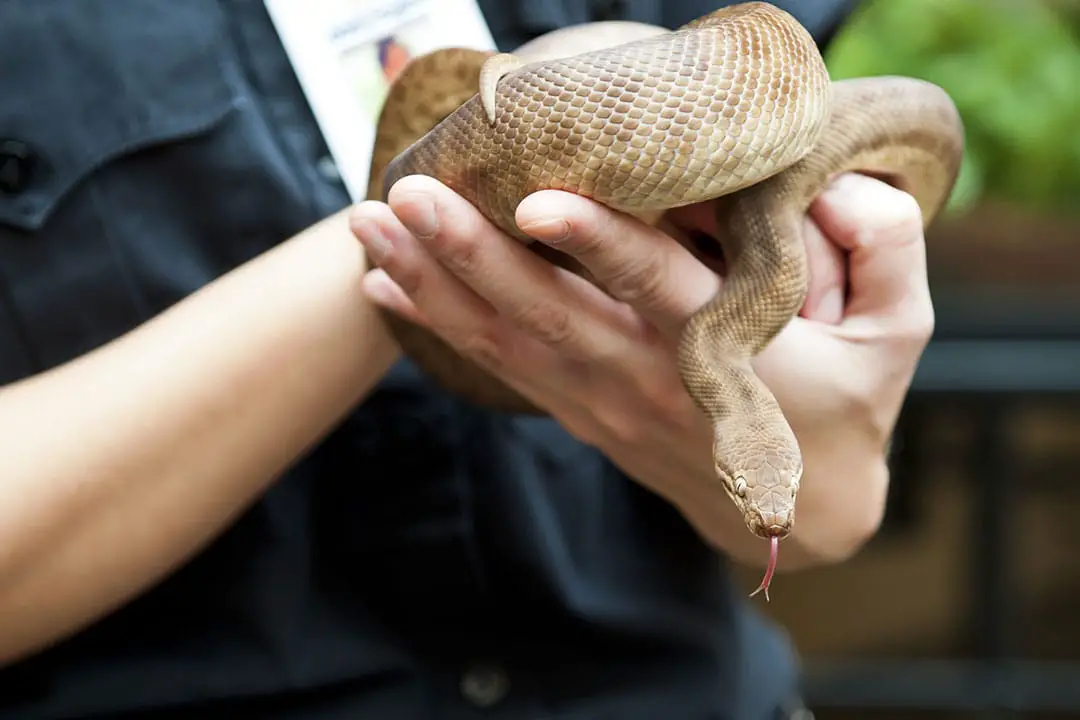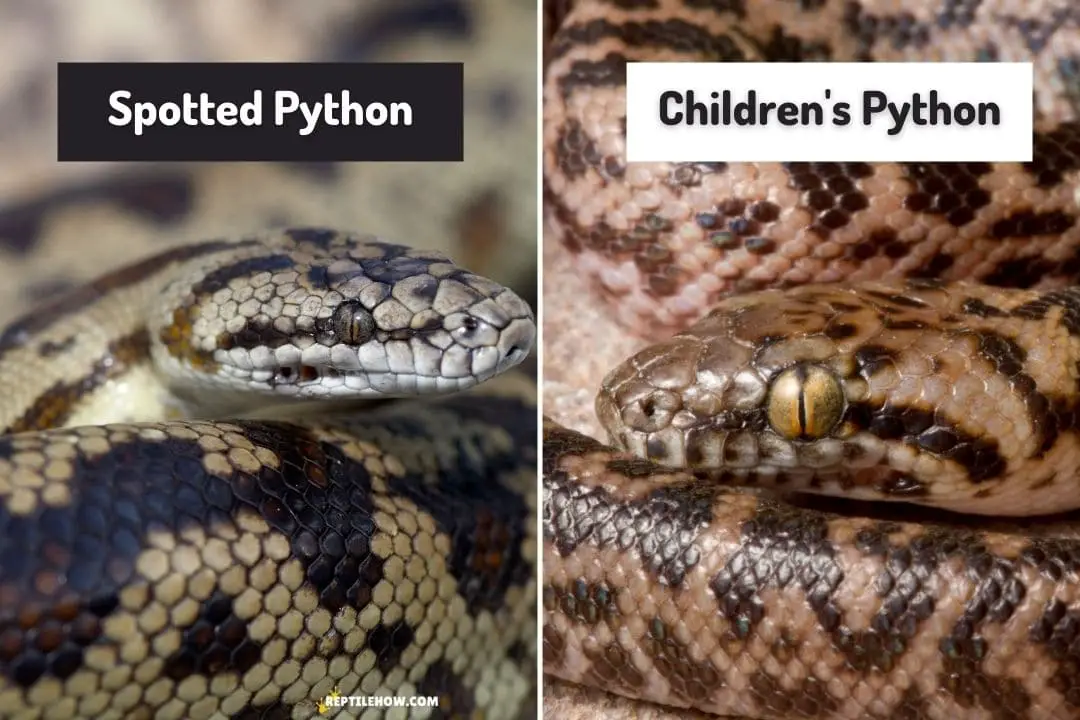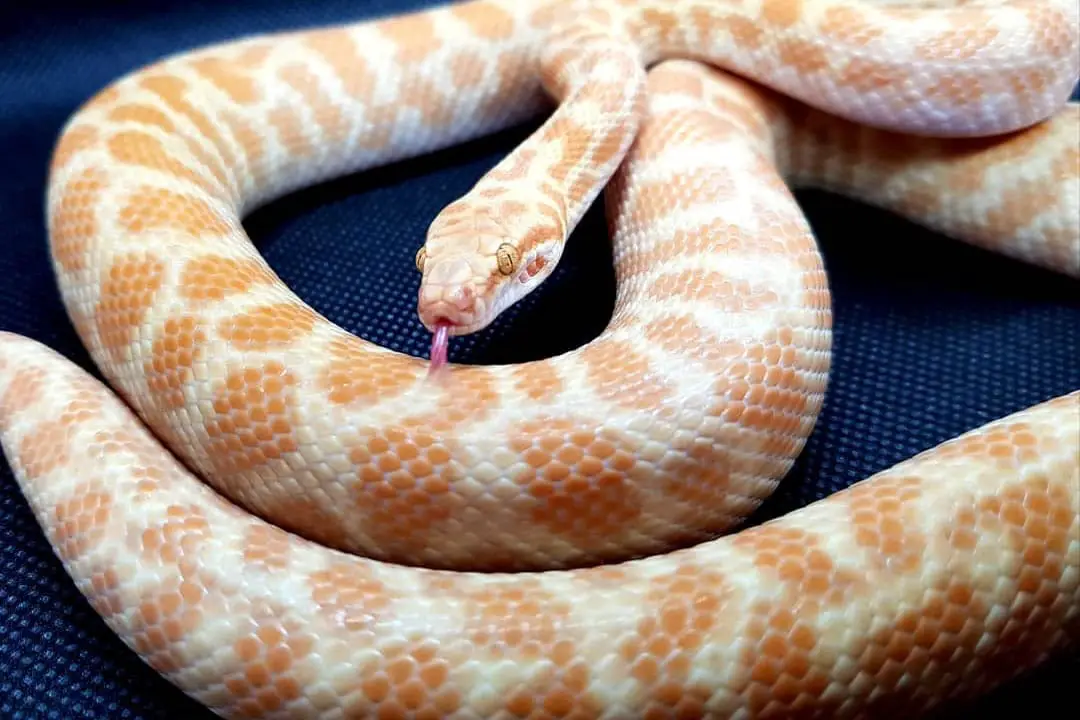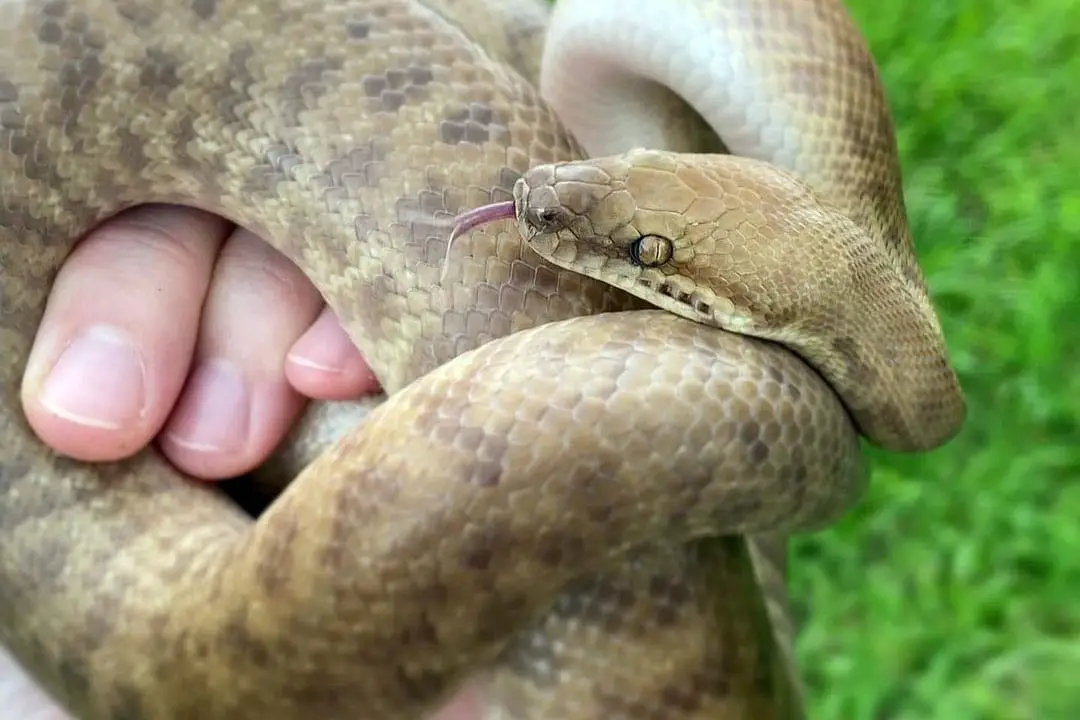The Children’s python (Antaresia childreni) is a constrictor snake found in Australia. These snakes are docile and typically small so they make a popular pet snake for beginners.
They can be found in a wide variety of habitats in the wild including grasslands, forests, wetlands, deserts, and more. Since they come from such a wide range of habitat types, they are more tolerant of care mistakes than other species.
These are semi-arboreal snakes, so keep in mind that your python will likely want to climb.
This species is polymorphic so even wild individuals can have a huge variety in appearance and size depending on where they were found.
The Stimson python was recently determined to be the same species since they are so genetically close over much of the range.
This guide will help teach you how to care for your Children’s python.
Housing
The goal of housing your reptile is to create a space that meets all of its needs and also allows for natural behaviors. You should create a space that is a slice of your snake’s natural habitat.
This means creating the right temperature gradient and offering plenty of spaces to hide and rest. You should also offer some vertical space to help your snake get exercise.
The right temperatures and humidity will help make sure your snake can shed successfully and stay healthy in the long term. You should also make sure the enclosure is secure so you don’t risk your snake escaping.
The enclosure itself and the decorations should also be easy to clean so you can keep your snake in a clean and healthy environment.
Remember, your new snake relies on you for every aspect of its life and care. Children’s pythons live to 30 if they are cared for properly, but poor care can kill them.
Enclosure
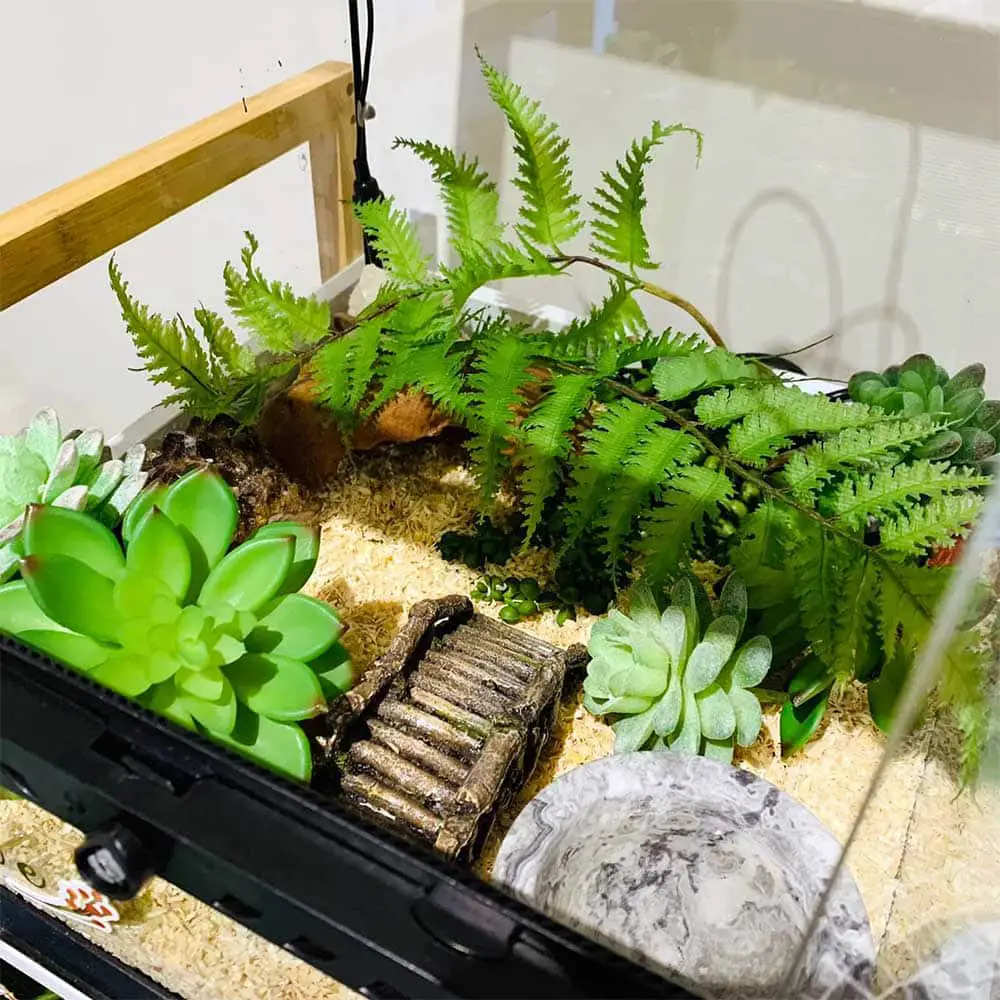
You will need an enclosure that offers enough space for exercise and can fit all the decorations and hides your snake needs to stay happy.
The general rule is that you need to make sure that an enclosure is at least as long as the snake is and half that in width and height.
Juvenile snakes can be kept in an enclosure that is no more than half their length, but after that, they absolutely need more space.
You should also be sure to decorate the childrens python housing and fill it. Most snakes dislike feeling exposed. Adding greenery and climbing branches can help fill space.
Ledges with overhangs can offer more space for your snake to rest if it likes.
Give your snake plenty of options and watch to see what it uses the most. This can help you decide how to change its enclosure as the snake grows.
Enclosure for Baby and Juvenile Children’s Pythons
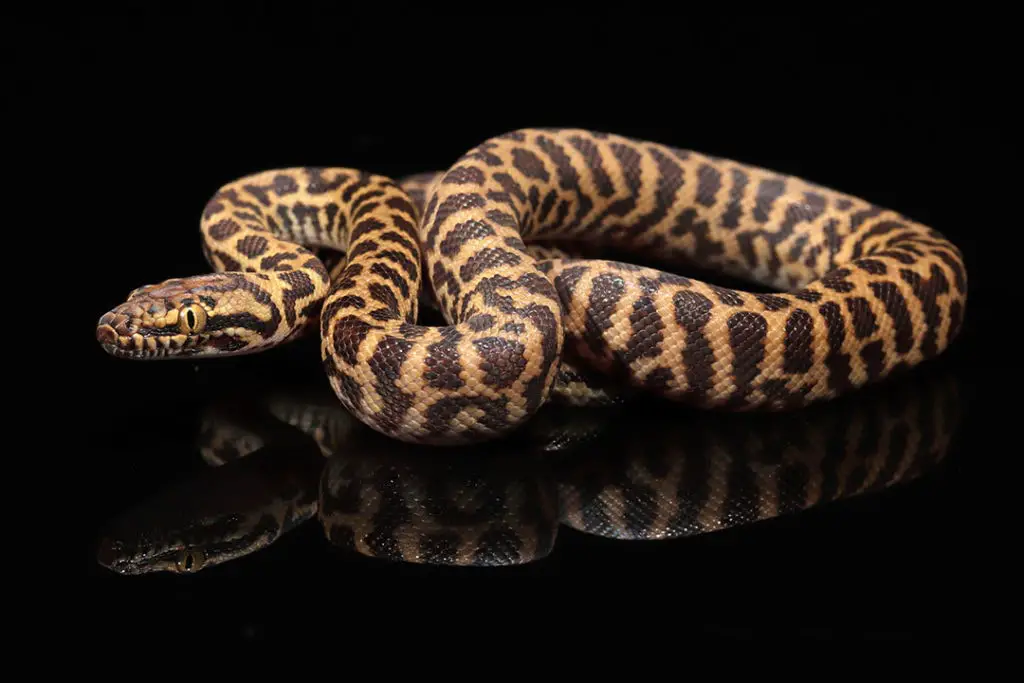
Young Children’s pythons need secure enclosures. You should ideally use an enclosure that opens from the front and offers easy access to the heating elements.
This enclosure from Custom Reptile Habitats is a great option for a young snake. It can keep your snake away from any heating and lights. It is also easy to install secure perches and backgrounds.
It is easy to clean and the doors allow you to watch your pet.
Enclosures with solid sides like this also feel more secure than a glass enclosure. The keyed lock also makes sure your snake can’t escape.
This could work for a small adult as well since some Children’s python localities stay around 3 feet, but adults do appreciate more space.
Enclosure for Adult Children’s Pythons
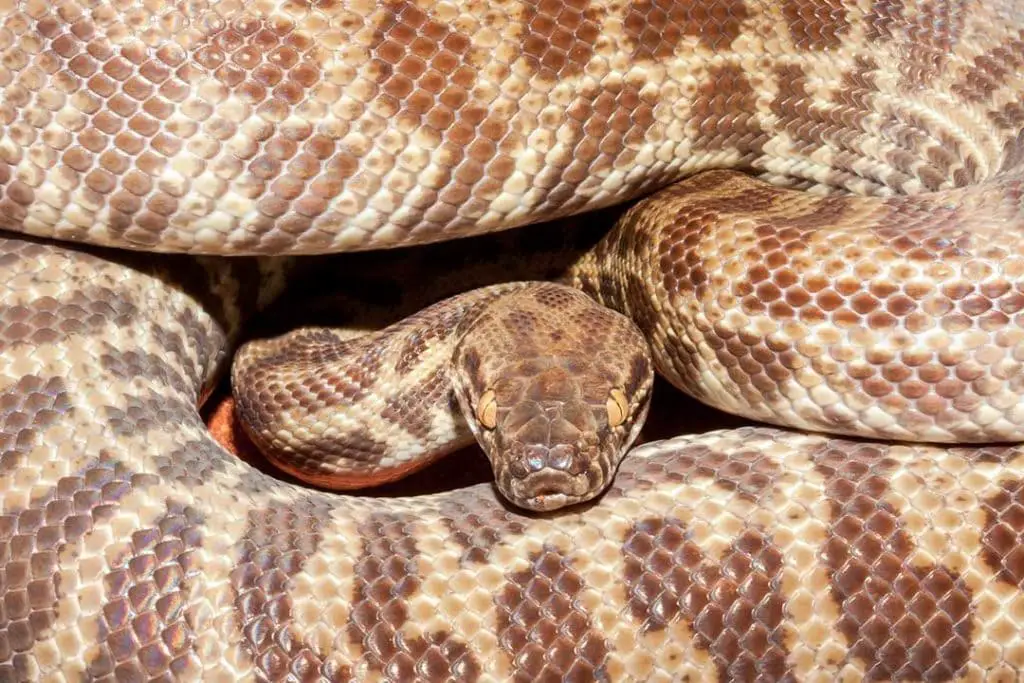
Adult Children’s pythons average 3-5 feet long depending on the locality of the snake. Once your snake is an adult, you should measure it and pick something at least as long as your snake.
For smaller adult snakes, this is a great option. It has keyed locks and plenty of ventilation for your snake. The depth also allows for bioactive setups if you want to try this out.
If you have a snake that is closer to 5 feet long, you will want a 6-foot enclosure.
Your antaresia python’s cage should offers secure locks to prevent escapes and extra height to give this semi arboreal species a chance to climb. Be sure to fill up the space so your snake feels more secure.
DIY wooden enclosures can work for this species, but I don’t recommend them due to fire hazards with heating elements, risks of rotting, chemicals used to treat wood that cam harm snakes, etc..
Substrate
Since Children’s pythons need somewhat higher humidity, you will need to make sure your substrate can handle some humidity.
Eco Earth is a great option along with most other coconut substrates. Aspen also works well, but it may try to mold more often. Paper towel works well if you need to quarantine your snake.
Make sure you never use aromatic woods like pine and cedar since these are toxic to reptiles. You should also avoid sand and cat litter. Some older care guides recommend these substrates but they are not safe for your snake.
Make sure you keep your substrate deep and spot clean any messes.
Heating

Children’s pythons are cold-blooded. They do not generate their own body heat. They rely on external heat sources to warm up enough to digest and perform other metabolic processes.
You need to provide this heat in a gradient so your snake can regulate its own body temperature.
Place all the heating elements on one side of the enclosure. Keep this basking spot between 85 and 90 degrees at all times.
A ceramic heat lamp or heat emitter in a good housing dome like this one and an under-tank heater like a heat mat can be combined for this species since they can get very sick if they are not kept consistently warm.
Make sure you use a thermostat to control the temperatures and check it daily with a digital thermometer and an IR heat gun.
What is the required temperature for a children’s python enclosure?
Children’s pythons need a temperature gradient between 78 and 90 degrees Fahrenheit. A Warm spot should be kept within 85 to 90 degrees, while the cool side should be between 78 and 80 degrees.
Be sure you check the temperatures in the hides and in any areas you want your snake to use.
Light
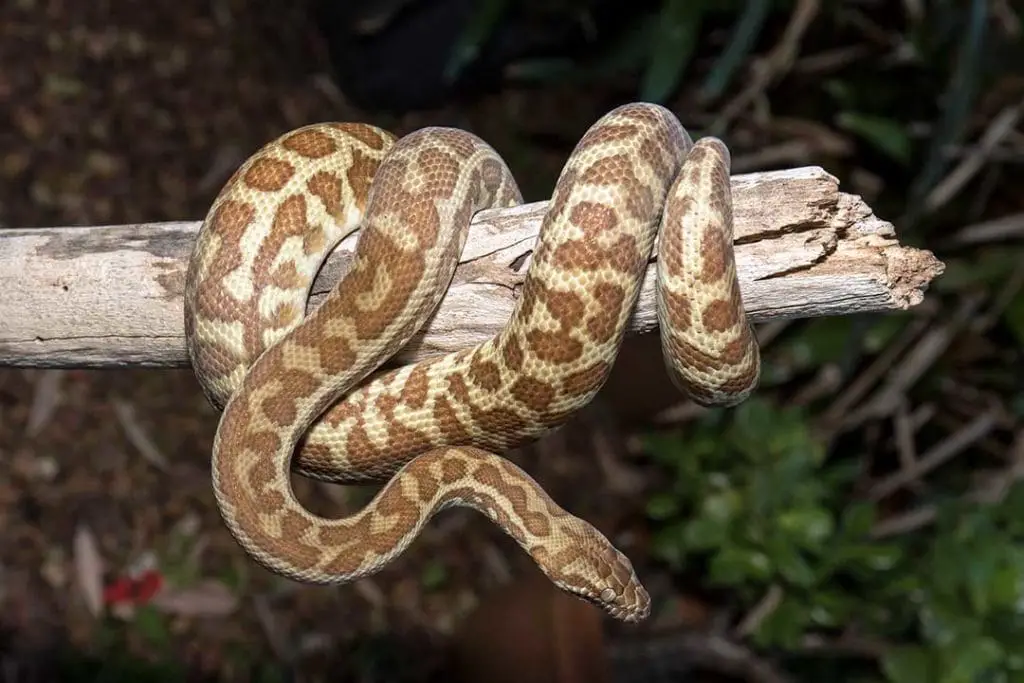
Snakes do not require UV light to be healthy, though it doesn’t hurt to offer it.
You can use a good lighting system to help show off the beautiful sheen that Children’s pythons have on their scales.
Be sure that your lighting is on a timer since these are nocturnal snakes. The lights constantly being on would stress out your snake.
Shelter
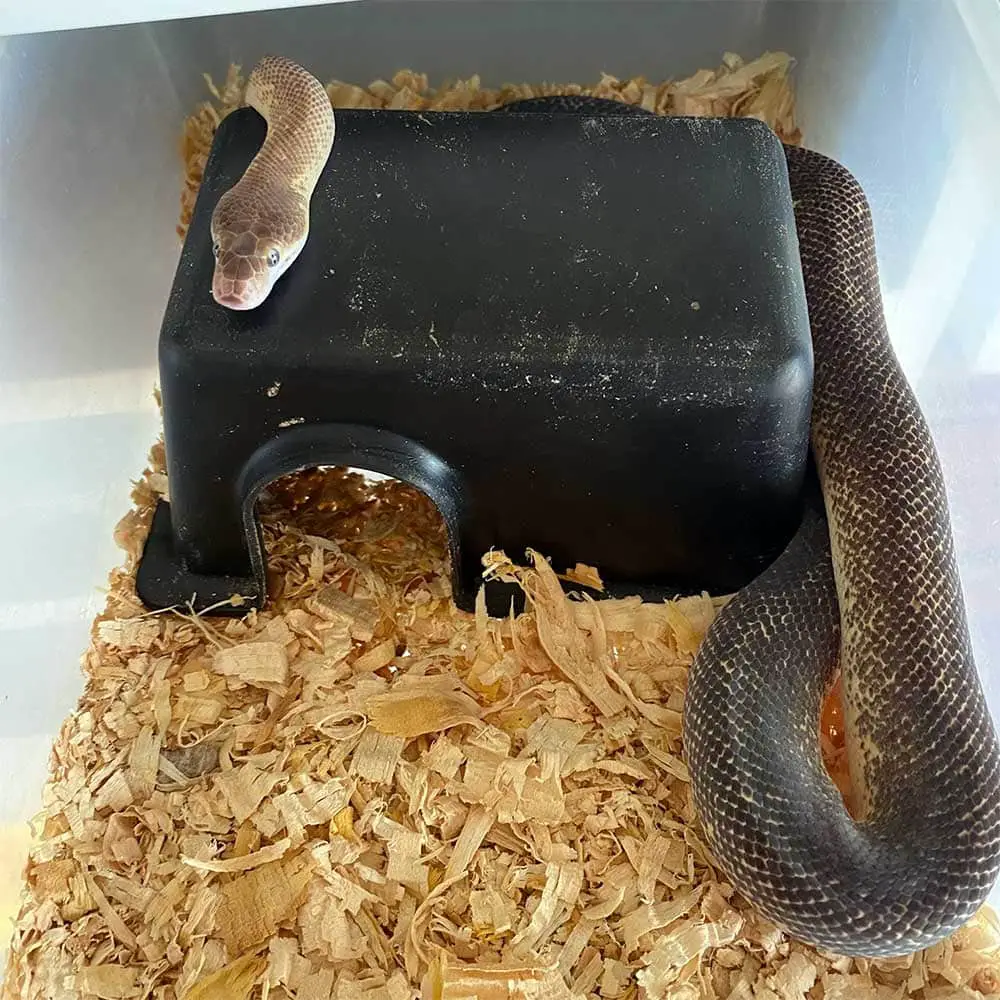
All snakes require shelter. Snakes are frequent targets for predators like birds, particularly when young. They need hides where they can feel secure.
Place at least two solid hides that just fit your snake with little room to spare, especially if hosting multiple children’s pythons.
You will want one on each side of the temperature gradient so your childrens python doesn’t need to choose between feeling safe and staying at the right temperature.
This is a great option that can also be used for a humid hide when it is time for your snake to shed. You can also offer more shelter by placing overhangs, plants, and pieces of bark to help your snake feel hidden.
Water
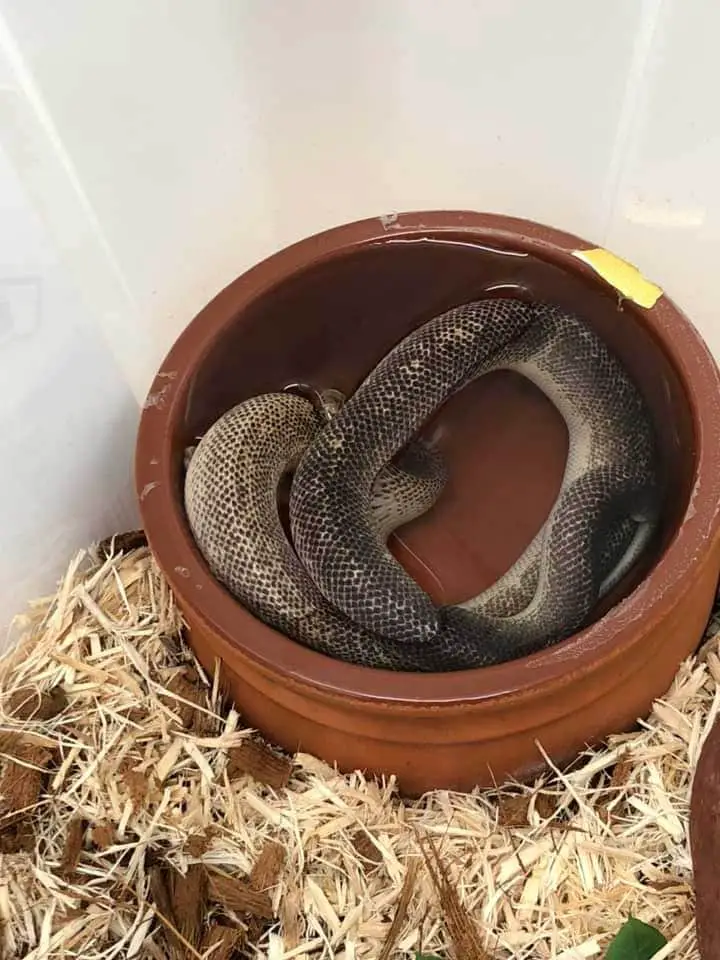
All snakes require fresh water for drinking. Many snakes also enjoy soaking in their water dish. This means you need a dish that can hold your snake.
A wide and sturdy dish is best. Look for something that is easy to clean since some snakes will poop in the water dish as well.
This is a great option and generally suitable for a young snake, though you may need to size up over time. Always aim for something wide and shallow.
Be sure your snake can’t tip it over either. Many snakes will hide under their dish, so it shouldn’t be too heavy or your snake can be crushed.
Humidity
Humidity in the enclosure needs to be monitored for your snake’s health. If the humidity is too low, your snake will have problems shedding and will become dehydrated.
If it is too high, your snake may suffer from rashes and other painful skin problems from too much water.
What is the required humidity level for children’s pythons?
Around 50% humidity works very well for Children’s pythons.
You should invest in a good digital hygrometer to check the humidity levels. The analog options can report the wrong humidity and harm your snake.
The water dish should help maintain humidity, but you can mist the enclosure and change the ventilation.
The recommended enclosure makes this easy. If your snake is getting ready to shed, offer a humid hide filled with damp sphagnum moss.
Enclosure Maintenance
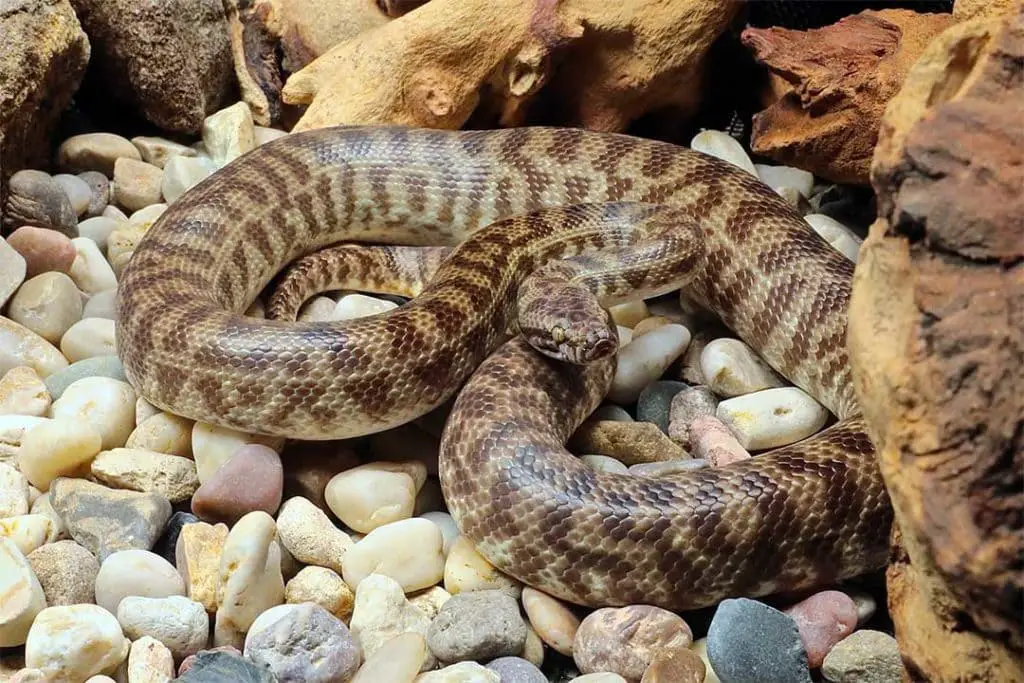
You need to keep up on cleaning to make sure your snake stays healthy. Snakes will get sick in a dirty enclosure. You should check for soiled substrate every day.
Take it out and replace it with fresh every single time. You should also be changing the water daily. If your snake defecates in the water, take out the dish and sanitize it to prevent illnesses.
You will want to wash the dish with soap and water every week to prevent the growth of bacteria.
Finally, once a month you need to do a deep cleaning if you don’t have a bioactive setup. Make sure you have a secure temporary enclosure for your snake.
This can be anything with ventilation and a locking lid. Take out all the decorations for cleaning and turn off the heating. Remove and dispose of all of the substrates.
Then scrub down the surfaces with a reptile-safe sanitizer.
Be sure to follow the directions and rinse well. You should wipe up any standing liquid and leave the enclosure open to dry out.
Then you can clean the hides and other decorations.
Be sure to sanitize what you can. Once everything is clean and dry, you can set the enclosure up.
Add new substrate and replace the hides and decorations. This is a great time to redecorate a bit to give your snake some enrichment.
Finally, turn on the heating and return your childrens python. Make sure you lock up well since your snake may decide it wants to explore the rest of your home.
Feeding
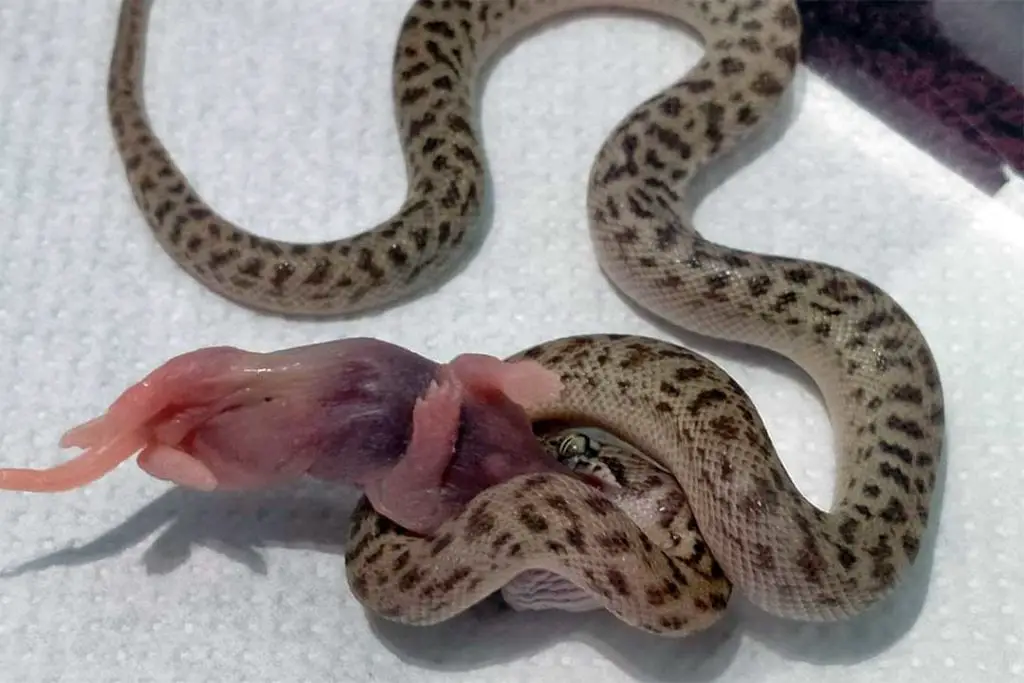
Children’s pythons in the wild will eat many vertebrate prey items. They eat birds, rodents, reptiles, and many other small mammals. The most famous prey for this species is small species of bats.
Children’s pythons will go to the caves where colonies of bats roost and pick a stalactite in the common flight path to leave or enter the cave.
The snake will then suspend itself and catch bats as they fly past. However, they are not particularly picky and will take any prey item they can catch and swallow.
They are constrictors, so they kill their prey by cutting off blood flow to the brain with their powerful bodies.
Type and Size of Prey
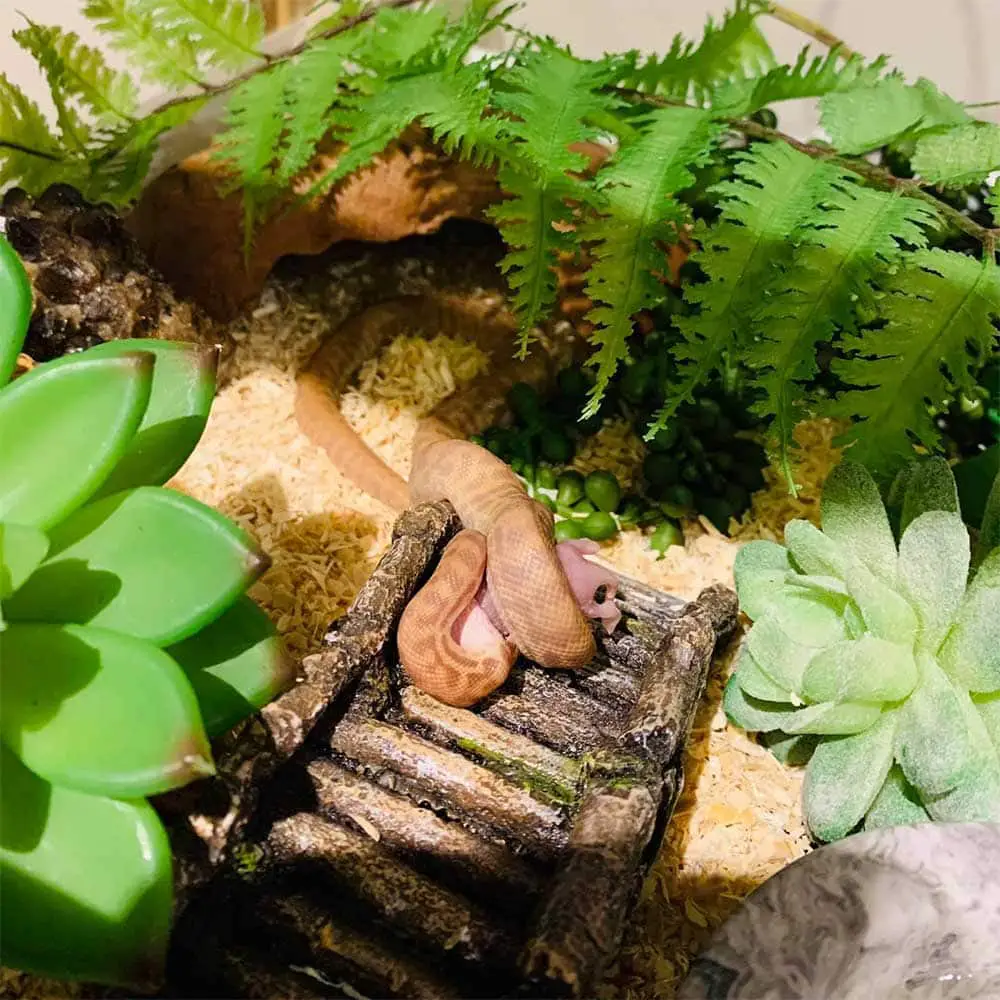
In captivity, Children’s pythons are typically fed rodents. You can feed either mice or rats. Most young snakes will need pinky mice since they can’t handle much larger prey.
What type of prey does a children’s python eat?
Aim for prey that is either about as wide as the widest part of your snake or about 10% of its weight. Prey can size up with your snake. Your adult may eat adult mice or small rats depending on how large your pet ends up.
You can feed in the enclosure if you like.
Snakes do not like being moved after a meal and may regurgitate or refuse food if you try this.
If you are worried about your snake snapping at you because it is expecting a meal, use a snake hook or paper towel roll to let your snake know when it is not mealtime.
This will teach it not to bite when you reach in to handle your snake or clean.
Frozen Vs Live

Many keepers disagree on whether you should feed frozen or live prey. Live prey allows for natural hunting behaviors, but it comes with some downsides.
The biggest is potential injury to your snake. A cornered rodent will fight back and can harm your pet. You need to supervise all live feeding sessions.
You also need to acquire live prey that is the right size before every meal. You will also need to care for the feeder until it is time to be eaten.
Frozen mice and rats can’t hurt your snake or give it parasites. You also have the option of stocking up on prey so you don’t need to go out.
Frozen mice can also be ordered online and shipped to your home. Micedirect ships a number of frozen feeders that are labeled to easily find the right prey size.
If you feed live you will need to find a local pet store or feeder mice breeder to acquire your prey from. Craigslist and Facebook along with local reptile shops can help you locate food for your snake.
Frequency
Generally speaking, a hatchling will eat once a week.
As the snake ages, you should decrease the frequency of meals. By the time your snake is an adult it will be eating every two weeks or so.
You should monitor your snake’s weight and body condition to make sure it is growing properly. You should see a steady weight gain until the snake reaches adulthood. Use a kitchen scale that can measure in grams to track more accurately.
Also watch the body condition. If you see the ribs or spine become prominent, you need to feed more often. If your snake is getting fat, feed less frequently.
Shedding
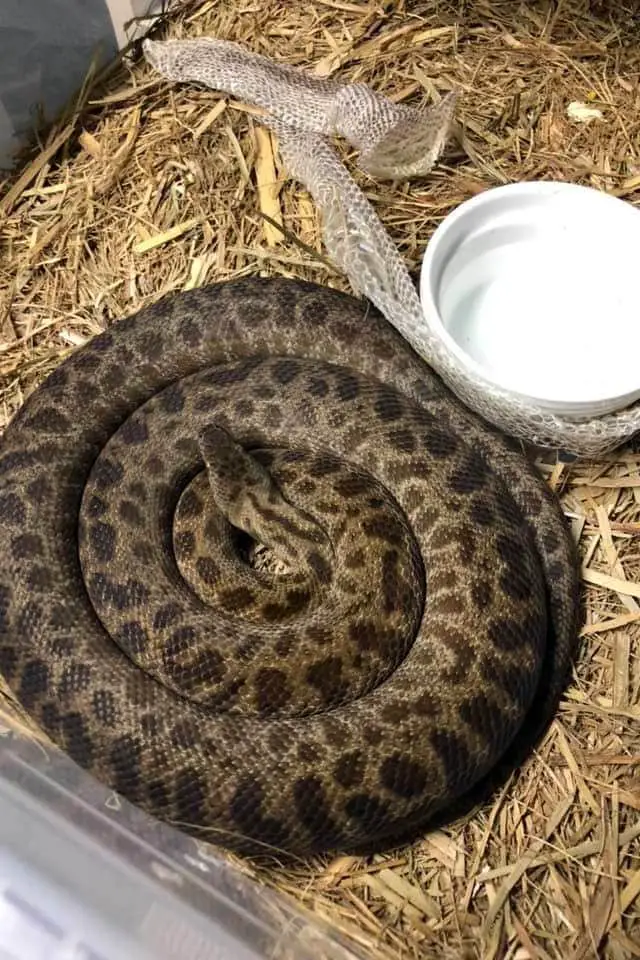
Shedding is the process where your childrens python shed the outer layer of the skin. This allows them to heal and prevent damage to the scales. Since their skin is less flexible, they need to shed the old skin to grow larger.
A build-up of fluid will separate the old layer of skin and also lubricate the skin to make it easier to crawl out of. You will see your snake’s eyes become cloudy or blue and the colors will dull.
During this time, your snake can’t see you well and will likely be more defensive.
Most snakes in shed will also not take food until they have finished shedding. It is essential that your snake sheds the skin in one solid piece. Stuck pieces of shed can cause infections and harm your snake.
This species isn’t too picky on humidity and many shedding issues are caused by poor temperatures.
However, raising the humidity a bit and offering a damp hide filled with damp sphagnum moss can help your snake shed successfully.
Offer a hide filled with the moss on the warm side in addition to the other hides. This will let your snake choose how humid it wants to be.
Check the skin after it has come off to make sure it is intact. In particular, look for the scales that protect the eyeball from drying out and the tip of the tail. Make sure your snake has shed properly.
If these parts stay in place, your snake could go blind or lose part of its tail. If you notice any stuck skin, place the snake in a container with a warm, damp paper towel for at least 15 minutes.
Then try to gently remove the old skin from your snake. Do not pull since this can hurt your snake. If you are having serious shedding problems, a visit to your reptile vet can help.
Hibernation
Brumation is the reptile equivalent of hibernation.
You do not need to brumate your snakes. In the wild, these snakes stay mostly active and will breed during the colder months. If you are not breeding your snakes, you do not need to worry about this.
Handling Antaresia Childreni Pythons
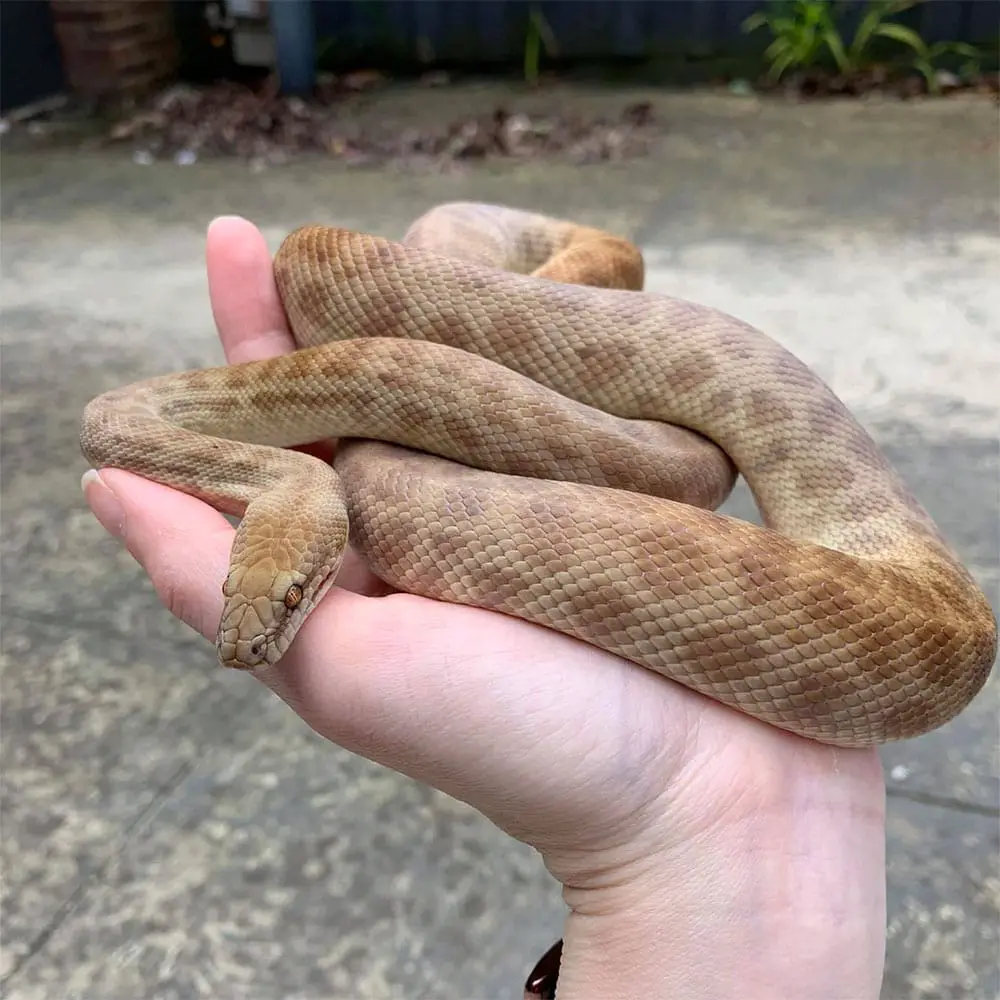
Children’s pythons are wonderful snakes that are usually friendly and very easy to handle. They are small and captive breeding has created animals that are very docile, well appreciated in the reptile community.
They are delicate though, so you need to be gentle. Do not allow children to handle them since they are likely to hurt the snake on accident.
You should be careful to avoid squeezing te snake since this can frighten or injure it. You should handle these pythons weekly to keep them tame.
Be sure you don’t try to handle 24 hours before a meal or for 48 hours after.
If your snake is shedding, you should also leave it alone unless the snake is having trouble with a stuck shed. Be sure you wash your hands and use hand sanitizer before you handle your python.
This helps prevent the spread of disease and makes sure you don’t smell like food. When you pick up your snake, do so from the side and allow the snake to crawl through your hands.
Once the snake is relaxed it will likely hang onto you and explore. These are active and curious snakes so most will appreciate a chance of scenery once a week. Be gentle and keep handling sessions positive and you shouldn’t have any problems with your pet.
FAQ
This section answers some common questions about the species. If you have a question that isn’t covered here, please leave it in the comment section below.
Are Children’s Python Aggressive?
Generally speaking, Children’s pythons are very docile with humans and rarely bite. Young snakes can be defensive, but once they learn you won’t hurt them, adult snakes tolerate humans well.
This non venomous snake can be aggressive with other members of their species, with reports that anthill python and children’s pythons will compete over food and mates if housed together.
Why are They Called Children’s Pythons?
The python species is named for John George Children, who was the curator of the British Museum’s zoological collection when the nocturnal species was described. john george children was the mentor of John Edward Gray, the man who first described the species in 1842 in torres straight islands northern australia.
Due to their polymorphism, and a variety of morphs available, they are often confused with the very similar spotted python.
Common Health Concerns
Parasites are always a problem for snake owners. External parasites like ticks and mites can weaken or injure your snake’s body. Some may pass on other illnesses, and are easily spread between enclosures and snake racks.
Look for drowned ticks or mites in the water. Mites look like black specks about the size of a poppy seed. Respiratory infections can kill a snake quickly. If you notice your snake breathing through its mouth or making strange sounds, take it in to your vet.
Snakes fed live prey can be injured and suffer from infections. Check your snake for injuries during handling sessions and take your snake in if you see signs of infection.
Refusing to eat
Children’s pythons and spotted python tend to be good feeders. They may stop eating of it is too cold, if your thermal gradient is not setup properly, they are breeding, or if they are in shed. These pythons may also stop eating if they are sick.
If you are not sure why your snake has skipped more than two meals, and has no feeding response, a visit to the vet can rule out serious causes.
Resources
Maternal brooding in the children’s python (Antaresia childreni) promotes egg water balance
Antaresia Childreni (Children’s Python) Diet. / Enloe, Chase; Bartek, Brett; Doody, Jean Sean; Gray, Callie; Kimes, Kara; Clulow, Simon; Deering, Stephanie; Fryer, Harry; Soennichsen, Kari F.; Webster, Grant.
The care of the Children’s Python (Antaresia childreni) – ALEXANDER HOSKING and GARY MARTINIC
OLIVIER LOURDAIS, BENOIT HEULIN, DALE F. DENARDO, Thermoregulation during gravidity in the children’s python (Antaresia childreni): a test of the preadaptation hypothesis for maternal thermophily in snakes, Biological Journal of the Linnean Society, Volume 93, Issue 3, March 2008, Pages 499–508, https://doi.org/10.1111/j.1095-8312.2007.00925.x
Conclusion
We hope you have learned how to care for these wonderful snakes properly.
They make wonderful pets and can live for up to 30 years with good care.
If you have any questions or comments, please leave them below.
